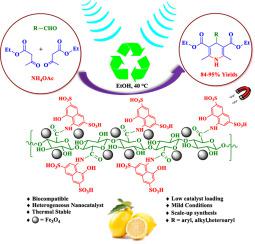Materials Today Communications ( IF 3.8 ) Pub Date : 2021-09-20 , DOI: 10.1016/j.mtcomm.2021.102791 Mohsen Bakhtiarian 1 , Mohammad Mehdi Khodaei 1, 2

|
In this study, we presented a bio-derived magnetic nanocomposite based on the pectin modified with 1-amino-8-naphthol-3,6-disulfonic acid in two steps. In the first step, 1-amino-8-naphthol-3,6-disulfonic acid (DSA) was grafted on the low-methoxy citrus pectin (Pec) and in the next step, simple immobilization of Fe3O4 nanoparticles resulted in the magnetized nanocomposites (Fe3O4-Pec-DSA). The structure of Fe3O4-Pec-DSA nanocomposites was confirmed by various physicochemical characterization methods. This nanocomposite was employed for the ultrasonic-assisted synthesis of biologically active 1,4-dihydropyridines in ethanol. Various parameters such as catalyst type, solvent, ultrasound power and frequency, temperature, time and catalyst loading were fully investigated to establish the optimal conditions. The remarkable activity of Fe3O4-Pec-DSA catalyst based on short reaction times (15–40 min) and high yields (84–95%) is ascribed to the synergistic effect derived from the catalyst structure due to the presence of –SO3H moiety and Fe3O4 nanoparticles and ultrasound waves. The magnetic character of the catalyst provided a clean and easy separation. The catalyst was stable at least 6 consecutive runs without remarkable structure alteration, verified by FT-IR, XRD, and EDX techniques. The stability and heterogonous nature of the catalyst were confirmed by a leaching test since no product was formed after removal of the catalyst magnetically. Moreover, the negligible leach of Fe3O4 nanoparticles in the acidic and basic mediums was supported by atomic absorption spectroscopy (AAS).
中文翻译:

在温和条件下使用基于经二磺酸修饰的果胶的生物衍生磁性纳米复合材料声化学合成 1,4-二氢吡啶
在这项研究中,我们提出了一种基于用 1-amino-8-naphthol-3,6-disulfonic 酸改性的果胶分两步制备的生物衍生磁性纳米复合材料。第一步,1-氨基-8-萘酚-3,6-二磺酸(DSA)接枝在低甲氧基柑橘果胶(Pec)上,下一步,简单固定Fe 3 O 4纳米颗粒导致磁化纳米复合材料(Fe 3 O 4 -Pec-DSA)。Fe 3 O 4的结构-Pec-DSA 纳米复合材料通过各种物理化学表征方法得到证实。这种纳米复合材料用于在乙醇中超声辅助合成生物活性 1,4-二氢吡啶。对催化剂类型、溶剂、超声功率和频率、温度、时间和催化剂负载等各种参数进行了充分研究,以确定最佳条件。Fe 3 O 4 -Pec-DSA 催化剂基于短反应时间(15-40 分钟)和高产率(84-95%)的显着活性归因于催化剂结构的协同效应,因为 - SO 3 H 部分和 Fe 3 O 4纳米粒子和超声波。催化剂的磁性特性提供了一种干净且容易的分离。通过 FT-IR、XRD 和 EDX 技术验证,该催化剂至少连续 6 次运行稳定而没有显着的结构改变。由于在磁性去除催化剂后没有形成产物,因此通过浸出试验证实了催化剂的稳定性和多相性质。此外,Fe 3 O 4纳米颗粒在酸性和碱性介质中的浸出量可忽略不计,这得到了原子吸收光谱 (AAS) 的支持。


























 京公网安备 11010802027423号
京公网安备 11010802027423号